BY LINCOLN ANDERSON | Updated Feb. 23, 4:20 p.m.: The city’s determined rollout of 5G megatowers in the West Village and Soho has, to hear some tell it, become one of the most heated issues in years in the Downtown area.
The city promises that the 5G towers will bring “ultra-fast network speed and expanded mobile coverage.” But residents are up in arms about lack of community process and notification behind the effort, of course the three-story-tall monoliths’ massive size and unsightly, giant microphone-like design — calling them glaringly noncontextual with low-scale historic districts — and their unsuitability for Soho’s hollow sidewalks, as well as health concerns about the potential electromagnetic impacts of the cutting-edge technology.
Meanwhile, the towers are redundant to similar 5G equipment that already has been and is currently being installed on rooftops and other poles, leading Community Board 2 to declare that there is “no immediate need” for the invasion of the 5G pod poles. A total of nine of the Brobdingnagian “Blade Runner”-style posts are planned in C.B. 2 — yet this would reportedly only be the first round of more waves to come. The organization CityBridge has the Link franchise for New York City.
Making the whole process seem both nontransparent and chaotic is a Byzantine set of guidelines. Meanwhile, making it feel despotic, the city claims the ability to override any efforts to restrict where the new towers go.
Herky-jerky start
Work to install the contentious structures recently started at two spots in the West Village on Washington Street. The effort has been starting and stopping in spurts, though, in response to calls from local politicians — particularly Councilmember Erik Bottcher — who have raised a cry whenever the workers start up again.
Following a hearing at Community Board 2 on Jan. 17 on the 5G towers issue, the full board on Jan. 19 called for a moratorium on the poles’ installation in the district, voting nearly unanimously with only one “no” vote. However, only a few weeks later, on Feb. 1, workers started carving out a foundation to install a 5G pole at W. 12th and Washington Streets.
Backing up the board, on Feb. 1, a group of local politicians (Bottcher, state Senators Brian Kavanagh and Brad Hoylman and Assemblymember Deborah Glick) promptly fired off a joint letter to the Office of Technology and Innovation seconding the call for a district moratorium.
On Feb. 3, Bottcher, ratcheted up the resistance, demanding an immediate halt on the 5G installations. The work stopped.
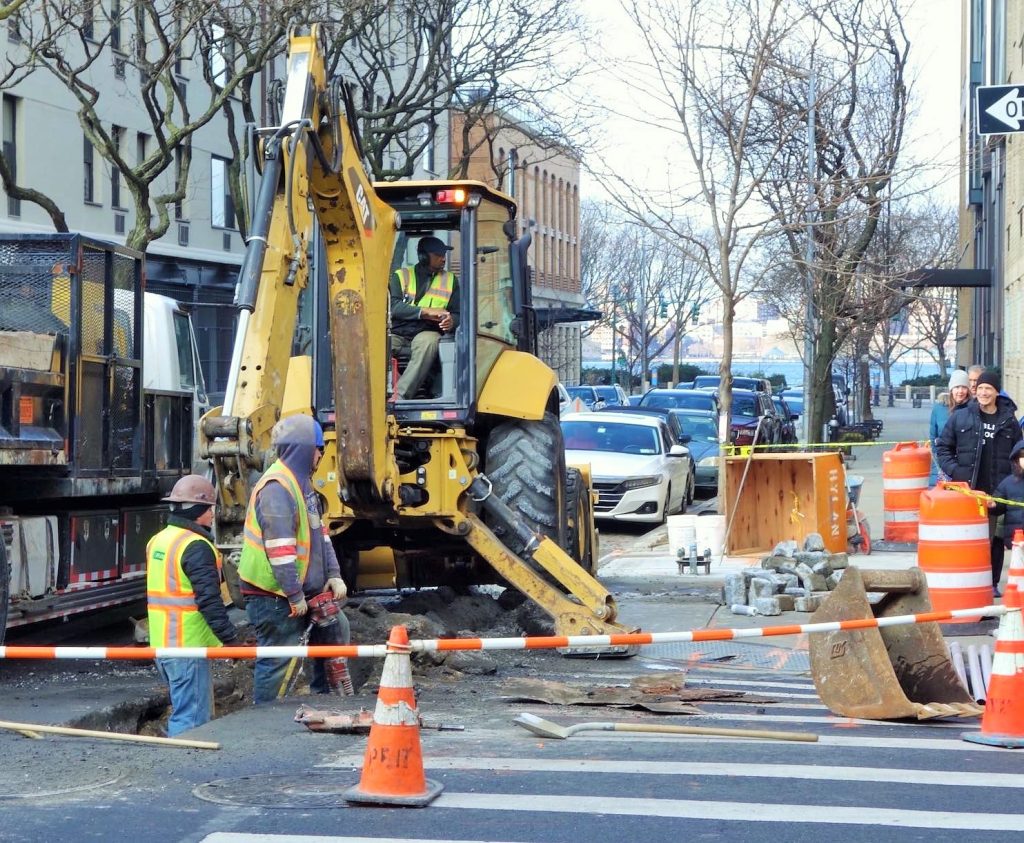
Yet, less than a week later, on Feb. 8, work again resumed at W. 12th and Washington Streets, where workers now began digging a trench to run electric and fiber-optic connections to the new foundation they had created the previous week for a planned pole.
In addition, the workers had expected to start digging a similar street trench the next day, Feb. 9, for the 5G tower at Horatio and Washington Streets. “No Parking Thursday and Friday” signs had been taped up and cones set out to block off parking spots. But then nothing happened as, again, the work ground to a halt.
As of press time, work on the two Washington Street 5G sites is on hold. Bottcher and the Mayor’s Office have agreed to meet and discuss the situation. The Village Sun has reached out to Bottcher’s office for an update.
‘People are really concerned’
Zack Winestine, a filmmaker and veteran West Village activist who leads the group Save Gansevoort, said the level of local concern around the 5G towers is unlike anything he has seen before. He noted that he regularly sends out blasts on “controversial issues” to a large e-mail list of residents, but that the reaction on the towers has been huge.
“I would say the stuff I send out with these Link5G towers — there has been more response to that than anything I’ve sent out in the last 20 years,” he said. “I’ve had 15 to 20 people get back to me. People are really, really concerned about this.”
Winestine said fueling the outrage over the 5G towers is “the fact that they are so out of place in the West Village — and that there has been such a lack of consultation and communication. [Potential] health reasons aside, people are seeing this as a massive intrusion in their lives.”
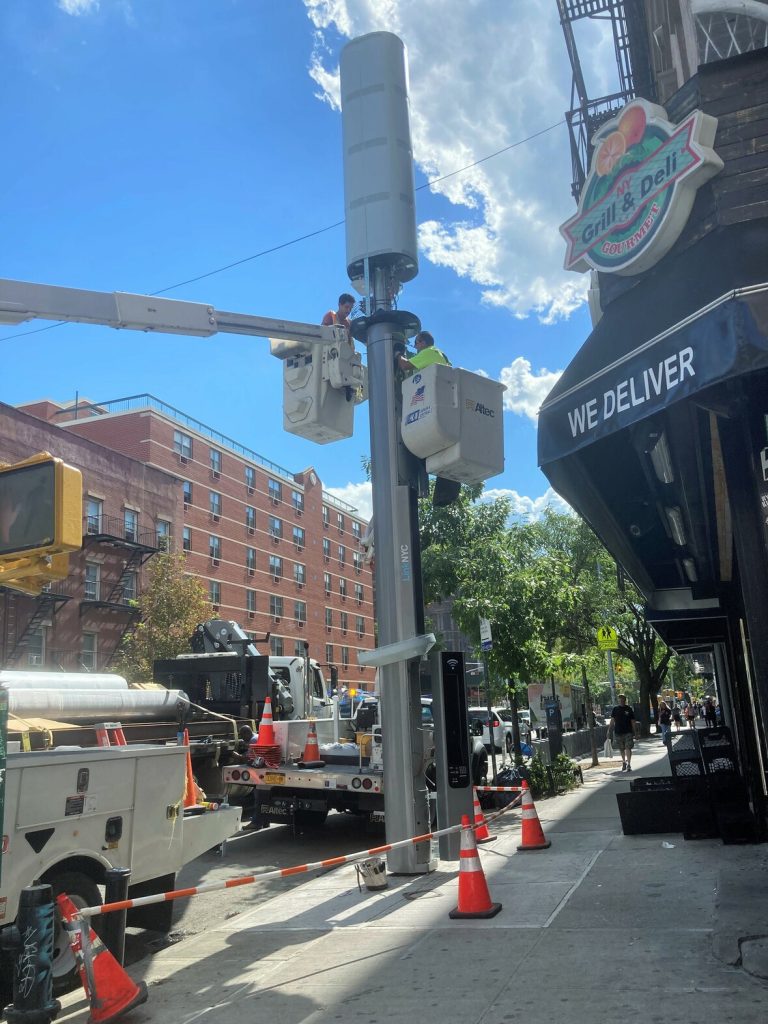
As for concerns about whether the higher-frequency 5G waves are bad for human health, Winestine said, “I think the city has been explicit that they will not accept arguments about radiation or frequency in the siting of these. They say they’re following the F.C.C. guidelines.”
The poles sport around four or five bays on top. These bays will mostly be leased to 5G carriers (such as Verizon, T-Mobile or AT&T), so they can beam data service to users, while one bay will provide free WiFi.
Then, there is also lucrative advertising — which Winestine personally suspects is driving the West Village installation effort. The ad panels (two per pole) will be around the same size as the ones on the city’s existing, smaller-sized sidewalk Link WiFi kiosks.
“Many of these towers are going to have large, illuminated advertising displays,” he noted.
However, according to Village Preservation, ads on the 5G poles will only be allowed in commercial- and manufacturing-zoned districts. But the Washington Street zone actually is commercial, though allows residential use.
‘Digital equity’ argument
Yet, the city has also been pitching the 5G monoliths altruistically, as a way to level the playing field, in terms of increasing “free digital access to connectivity, information and telecommunications.” (“Playing,” literally, since the increased speed of 5G is touted as great for gamers, as well as movie downloads.) Around 3.4 million New York City residents currently lack access to home and mobile broadband, according to O.T.I.
“The Office of Technology and Innovation is saying this is an equity issue and these towers will be built in digital deserts,” the West Village activist noted. “But this isn’t a digital desert, so why are these towers being built here?”
Indeed, speaking last July at the installation of the city’s first 32-foot-tall 5G pole — in the Bronx — O.T.I. Commissioner Matthew Fraser declared, “Today’s Link5G launch represents a dramatic leap forward in New York City’s efforts to bridge its long-standing digital divide… . Ninety percent of the 2,000 kiosks that will go live will go to the neighborhoods that have been historically underserved. Equity is at the heart of the 5G rollout.”
According to the C.B. 2 Quality of Life Committee’s resolution from January on the issue, “CityBridge is required to site 90% or more of new Link5G terminals outside of Manhattan below 96th Street in order to fulfill its mandate of providing broadband equity and closing the digital divide, with additional requirements to site a certain number of terminals in identified ‘equity community districts.'”
(To read the city’s Link5G proposal, which outlines the structures’ design and the program’s goals, click here.)
Meanwhile, Winestine noted that the Village area’s existing fiber-optic cable network (landline) is reliable and its bandwidth more than adequate for most residents’ needs.
“We just get the platitudes from the city that New York is a digital desert and that we have to move forward,” he scoffed.
‘City flouting its own rules’
Not all the proposed tower sites are listed in publicly accessible open data, he complained, adding that O.T.I. is blatantly flouting its own rules about not siting the unsightly structures next to individual landmarks.
According to Village Preservation, however, only Link5G towers earmarked for spots that were not pay phones prior to 2014 or within historic districts must be listed in open data. Any spot that was once a pay phone is apparently fair game for a towering 5G transmitter. And yet, Winestine noted, none of the proposed West Village locations that were missing from open data are former pay phone sites.
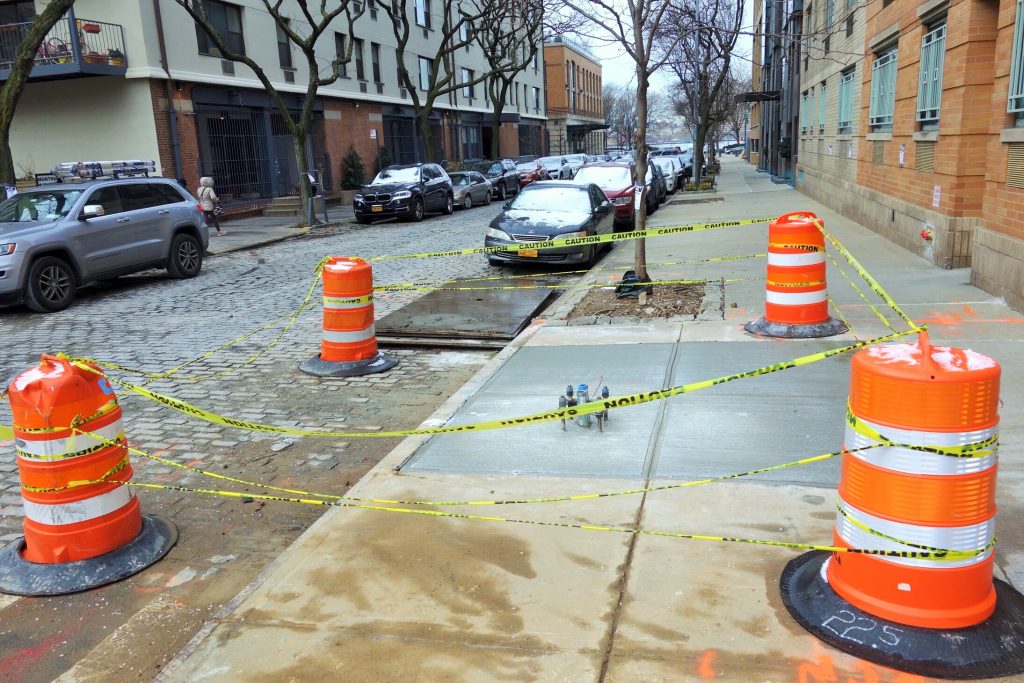
Six of the proposed nine C.B. 2 locations are within landmarked historic districts, with two (820 Greenwich St. and 771 Greenwich St.) in the Greenwich Village Historic District, two more (568 Broadway and 110 Prince St.) in the Soho-Cast Iron Historic District, and two others (113 Horatio St. and 108 Gansevoort St.) in the Gansevoort Market Historic District a.k.a. the Meatpacking District.
Winestine noted that plans for the two 5G towers in the Meatpacking District call for advertising panels, which violates O.T.I.’s guidelines prohibiting these ad displays within historic districts.
In addition, at least two 5G towers are slated for installation next to individual landmarks, another violation of the guidelines. One of these is proposed at 445 West St., at Bethune Street, right next to Westbeth Artists Housing, and the other at 113 Jane St., next to the landmarked Jane Hotel. The latter installation site currently is listed on open data — yet is conspicuously not among the spots that CityBridge told C.B. 2 about.
As for the two Washington Street sites where work has started, they’re currently the only ones earmarked for the West Village that are not in a historic district or adjoining an individual landmark — although they are directly across the street from historic districts.
“It’s very hard to respond or organize a community response to this amorphous mess,” Winestine protested. “This gets back to what the hell is going on with O.T.I.? Their inability to follow their own guidelines.”
As for where things stand with work on the stalled Washington Street 5G sites, Winestine shrugged, “The situation remains fluid.”
Winestine and Village Preservation members have vigilantly been keeping Bottcher’s office posted whenever they spot work starting up at the two sites.
‘Violating guidelines’
Like Winestine, Andrew Berman, Village Preservation’s executive director, accused City Hall and CityBridge of trying to flout the poles’ siting guidelines, as well as other commitments.
“The city has stated publicly at community meetings and in writing that the towers shouldn’t be sited next to individual landmarks or in historic districts without going through full Landmarks Preservation Commission public review,” Berman said. “They have attempted to violate those guidelines in several cases and been called out for it, usually resulting in work or progress halting. They had also begun foundation work for a couple of sites on Washington Street recently, even though they told the public at C.B. 2 that nothing was finalized or imminent and they were continuing to accept comments about siting. We and others immediately reached out to city officials, including Erik Bottcher, to object to this breach of commitments and the city halted work. The status of these two possible tower installations is unclear.”
Village Preservation has been generating hundreds of letters to city officials, urging a halt to the program, and in January Berman also wrote directly to city officials, accusing the 5G siting process of being “shrouded in secrecy” and characterized by “disturbing opacity.” Though O.T.I. publicly says it wants a “robust public review” of the plan, in reality, stakeholders’ input is “purely advisory,” and any “limitations” regarding siting can simply be vetoed by O.T.I. Chairperson Fraser, Berman noted in his letter.
Echoing Winestine, Berman told The Village Sun that the opposition to the humongous towers has been particularly strong.
“I can tell you that there are few things in recent years we have heard from so many about,” he said.
(Village Preservation has created a resource sheet on the 5G tower plan.)
Mounting concerns amid the murk
According to an O.T.I. spokesperson, the “LinkNYC team” first pitched the proposed Link5G locations to C.B. 2 on Oct. 17. Amid growing calls for basic information about the rollout, O.T.I. and CityBridge representatives agreed to give a presentation to the C.B. 2 Quality of Life Committee on Jan. 17.
Will Benesh, the Quality of Life chairperson, said the committee’s written resolution necessarily responded to a wide array of complaints about the Link5G rollout. Turnout at the committee meeting was unusually high — more than 100 people — and no one from the public spoke in favor of the plan.
“Our resolution was pretty comprehensive,” he said. “Clearly, there was a significant amount of concern — everything from design and aesthetics [of the Link5G towers], the vaults in Soho, the landmarks issues, safety, to privacy concerns [data harvesting]. We tried to synthesize all the concerns. We called for a moratorium; other community boards called for a moratorium. There are a lot of people saying this should stop,” he said of the contentious 5G buildout, “but it doesn’t seem like they are.
“There are many, many people concerned about these and not just in our district — and that’s a fact,” he said. “I think it’s untrue to characterize this as something that not many people care about.
“Pole-top and rooftop 5G is out there already,” he added. “We were asking them, why do we need all of that, plus this? There’s no problem with digital access in our neighborhoods. It’s kind of superfluous.”
Equity zones
Under the Link5G plan, Community Board 3, covering the East Village and Lower East Side, is considered one of 13 “equity zones” — an area in need of better digital connectivitiy. C.B. 3 is slated to get a minimum of 65 of the gigantic 5G poles — an amount at the higher end of the buildout for the 13 underserved districts. Conversely, C.B. 2, covering the West Side, is not deemed a digital equity zone.
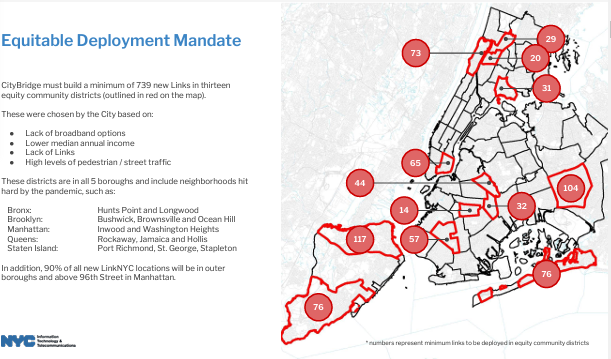
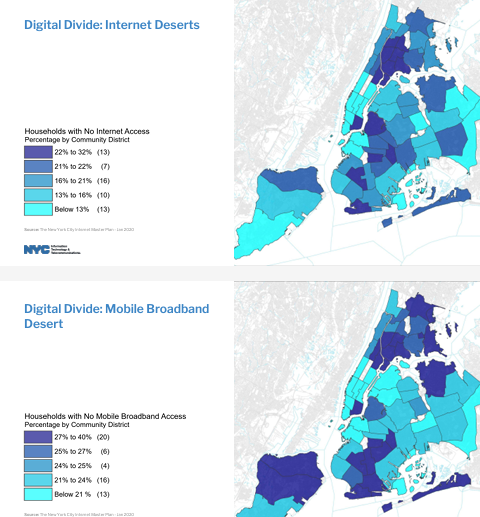 “A part of this [plan] was really focused on digital equity,” Benesh noted. “We felt this wasn’t an area where there were any issues with digital access.
“A part of this [plan] was really focused on digital equity,” Benesh noted. “We felt this wasn’t an area where there were any issues with digital access.
“You definitely have a group of people who are concerned about the electromagnetic waves and the health effects, and they have been showing up at [community board] meetings,” he added. “I’m not a doctor. I can’t speak to that. I just know a lot of people are concerned about it.”
For what it’s worth, the city’s Link 5G proposal says that transmitters must be a minimum of 19.5 feet above the ground per F.C.C. safety regulations.
A ‘smashing’ intro in Soho
In Soho, concerns are particularly high about the huge towers’ impact on the area’s unique physical infrastructure — namely, it’s hollow vaults under sidewalks.
Ronnie Wolf, who lives at 458 Broadway, said that in January, an outfit called Triumph construction, with permits from the Department of Transportation, cut into the building’s sidewalk under the premise that they were “removing old telephone lines.” (Decades ago the spot had three sidewalk phone booths, one on Broadway and two on Grand Street.)
The workers wound up slicing through existing sidewalk vaults, which the co-op had previously waterproofed at considerable expense, leading to rainwater pouring into the basement for a month. CityBridge has declined to address the problem, Wolf said. On top of that, in February, CityBridge then cut two more holes into the 1890s building’s Grand Street sidewalk.
(Soho’s hollow sidewalks are a remnant from its 19th-century, pre-electricity, industrial past when its basements were factories lit from above by small, clear, glass circles set in cast-iron sidewalks. They also explain Soho’s dearth of street trees.)
However, these Soho sites actually are not on the list of initial 5G tower placements in C.B. 2. Perhaps they are being prepped for a yet-to-be-announced second round of installations? Again, every former pay phone location is a potential 5G megatower site.
“We are a co-op of eight individuals and it is expensive and time-consuming to hold the city and the franchise they partnered with accountable!” Wolf said. “Litigation appears to be our only option. To repair and restore our vaulted sidewalk could definitely be hundreds of thousands of dollars because waterproofing of vaulted sidewalks is a very tricky endeavor to succeed!”
The spot is located within the Soho Cast-Iron Historic District, so L.P.C. would need to grant approval for any 5G tower installation there.
“What ‘could happen’ in historic districts actually did happen,” Wolf declared of the possibly rogue 5G-related work. “Others could possibly experience the same outcome if no one holds CityBridge and all the other parties involved accountable and insure they do their due diligence and engage with property owners before making sidewalk cuts.”
O.T.I.: ‘5G also for workers, visitors’
In a statement to The Village Sun, a spokesperson for the Office of Technology and Innovation, said the 5G towers rollout in areas like the West Village and Soho is about more than just meeting the basic needs of residents, and that the city plans to keep up “the conversation” with the community.
“The Adams administration believes that digital equity is a human right, regardless of where you live, work or visit in New York City,” the spokesperson said. “Just because some residents in a neighborhood enjoy strong connectivity does not guarantee that the New Yorkers who work in or visit that neighborhood enjoy the same. Link5G will deliver faster cell phone service, free WiFi and free nationwide calling, among other digital amenities. The LinkNYC team has engaged elected and community stakeholders on proposed sites in Community Board 2 since October 2022, and looks forward to continuing the conversation on these critical neighborhood investments.”
According to O.T.I., since LinkNYC’s launch in 2016, the sidewalk kiosks have connected more than 12 million New Yorkers and visitors with free WiFi, plus provided more than 30 million free phone calls — all at no cost to users or taxpayers. Around 425,000 calls are made from LinkNYC kiosks per month. During the pandemic, 30 percent of users said LinkNYC kiosks were the only broadband Internet access they had.
5G needed for AI, VR and IoT
Although the city is not pitching it this way, 5G — with its low latency (as in, minimal delay) and greater bandwidth — is also seen as potentially transformative for the future in terms of enabling virtual reality (VR), artificial intelligence (AI) and also the Internet of Things (IoT), from Alexa and robot vacuum cleaners to driverless cars. However, according to the city, AI, VR and IoT are not the impetus behind the 5G towers rollout.
As for the existing LinkNYC kiosks that were installed starting in 2016 and now seem downright tiny at only 10 feet tall, the plan is to keep them out there, too, the O.T.I. spokesperson said. The more bandwidth, the better.
Corrections: The initial version of this article improperly quoted a spokesperson from the city’s Office of Technology and Innovation saying that O.T.I. rejected the premise of the question as to whether the existing network of 10-foot-tall LinkNYC street kiosks is adequate to serve the needs of Community Board 2. In addition, a description of 5G and how it can enhance uses for virtual reality, artificial intelligence and the Internet of Things was wrongly attributed as a quote from the O.T.I. spokesperson. That information, in fact, came from a wireless company’s Web site, not from O.T.I. The Village Sun apologizes for the errors.

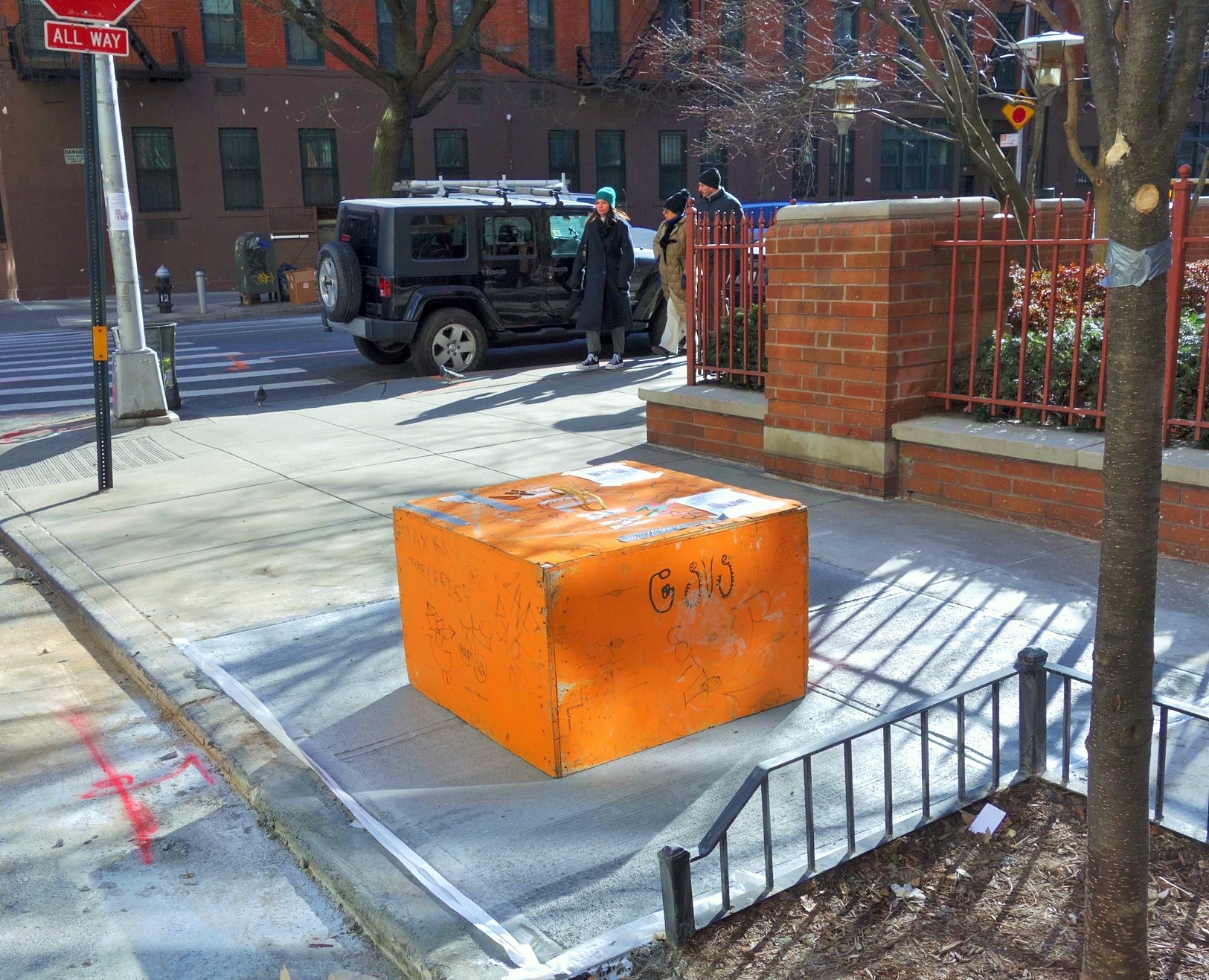
They re digging again this morning, March 30th, on the north/west corner of Horatio and Greenwich St.
Every single time you vote for City Councilmembers and pols who are funded by lobbyist groups, this is what you will get.
Tell a friend.
Completely outrageous that work already started before resident views are taken into account. We neither want nor need these towers.
It is outrageous that this is being built in a historic district in which it will be totally our of character. There are many less obtrusive areas to build this close by, but I assume Verizon is against it because it will then lose the opportunity for revenue from its ad panels. Capitalism run amok.
As a neighbor whose block is threatened by one of these large and unnecessary 5G towers, I am strongly opposed to their installation since the area is adequately covered by mobile service. The OTI and LinkNYC have a lot of explaining to do, having violated their verbal commitment at a CB2 hearing to engage the community on the matter. The tower pictured at the top of this article, which is planned for the corner of Horatio/Washington Streets and is expected to have a digital ad display, stands to obfuscate the stop sign (also visible in the photo) at the corner, and this will create a pedestrian hazard on an intersection that is heavily trafficked by local families and visitors to the neighborhood alike.
I am an immediate resident of this area and find the towers, absolutely redundant and disproportionate in scale. It is obvious that this is a business push from the Meatpacking BID association, a business district that is heavily weighing on our residential areas and imposing on them. Instead of serving underserved areas of the city that would greatly benefit from better wifi, there is no need here. We are already overstimulated, overexposed to merchandise and overly invaded by business interests. I strongly oppose these towers.
We do not want these in our historic district/meatpacking area. They are a blight to our beautiful streets. Our connectivity is fine. We don’t want them or need them.
The push for these towers in the Far West Village/Meatpacking is fueled entirely by the profit motive, not by “equity” or any other acceptable motives. There clearly are underserved communities elsewhere in NYC but we aren’t one of them, so it defies belief OTI is so fixated on erecting towers here. NO ONE WHO LIVES HERE NEEDS THEM OR WANTS THEM. Anything OTI may say to the contrary is based on no evidence whatsoever. They failed to ask for community input, and then when they got it and didn’t like what they heard, they started trying to refute it and may well eventually ignore it entirely. We will not accept that result.
Unwanted, ugly and unnecessary!!
They are totally underestimating the opposition in the west village/meatpacking district!!! I have lived here for 25 years. I have a kid in the public school and a dog I walked. I go to every community meeting and as many events as possible. Everyone is against this!
Please do not build these horrific towers in our beautiful neighborhood. We don’t want them and we don’t need them.
This is an outrage, plain and simple.
They are ugly, they are unwanted, they are being forced down our throats in record time. The last community board meeting (which was packed, by the way, there with not a single person saying “what a great idea!”) was on Zoom… why? so that we couldn’t shout down the mounds of bulls**t that was being fed us by the “experts” — who were in actuality publicity people for CityBridge/LinkNYC.
These people talked forever, never answering a question directly, and kept harping on all the “good” it will do our community.
None of us bought it.
Yes, there are places in our city that don’t have good wifi — please take your goodwill to those areas, but don’t try to pull the wool over our eyes.
We must fight this tooth and nail, and it will be a hard fight for many reasons, not the least of which is that the city will get millions from this deal. They have sold out our fine landmarked area in order to appease Verizon/Sprint/etc, who will rent out these monoliths — and the CityBridge/LinkNYC will then pay the city.
Let’s keep track of every elected city official who caves to this, and let them know that this will be their last term in office if this goes through.
Giant three-story-tall Q-Tips with lit-up advertising displays all over our sidewalks? What the heck are they thinking?
Why has Europe refused to deploy this technology??
Because Europe puts their citizens above their corporations.
Yes we residents have WiFi but advancing availability for those that don’t is important. And for those buildings that cannot choose an internet provider because only one is available, this can allow us to make providers work for us.
You’re kidding right? I can’t find a single person in the W.V. that does NOT have good wifi. And the fine Spectrum repairman who came to fix mine said, “Get ready because the bosses want 10G all over the city.” I asked why on earth would they, that doesn’t sound residential at all. His answer: “They want to do it for the big businesses, it has nothing to do with the residents”. $$$ and greed at its finest.
Perhaps the expression
“Follow the Money”
applies to this issue !
S Barry
I absolutely do not want this monstrosity outside my window. Corporate greed at its finest.
These things are so ugly. Can’t you fit them in a light pole? There are millions of light poles already in NYC, I bet you can put the equipment from one of these new 5G towers into those things without adding new clutter to the streets.
As our friends in the Bronx would say, fuggedabutit and give this one healthy Bronx cheer. These are unsightly, take up PUBLIC space, despoil our neighborhood. The drivers are revenue related but sure as hell, my property taxes will not go down. But the KEY ISSUE, we are not underserved and we don’t need them and nor do the countless visitors that fuel the economic health of our communities. NOTICE how you don’t see this on a) Little Island, b) Hudson River Park c) the High Line, let alone hanging off of all the new residences abutting the High Line d) the former Nabisco bldgs / now Google’s and Chelsea Mkt.
We dont WANT them because we dont NEED them. My property taxes go toward maintaining a historically unique area. THESE ARE TRAVESTIES.
Digital equity, economic justice, helping the poors… more smokescreens for giving away the commons to the likes of Verizon, who will be sending you monthly invoices for your new fabulous 5G coverage. This 5G transition ends the need for them to run cables into your building, saving them tons of money. It will require you to buy a receiver and place it outside your window, and run a wire into your apartment to your wifi transmitter/router. Or buy this new window-affixed gadget developed by Verizon. Get ready to pay. Question remains, when will 4G go the way of 2G, 3G?
from https://www.fiercewireless.com/5g/editor-s-corner-verizon-says-its-new-indoor-outdoor-prototype-5g-modem-solves-one-28-ghz-biggest
“Verizon is hoping to use its 5G Technology Forum network specifications, developed with Cisco, Ericsson, Intel, LG, Nokia, Qualcomm and Samsung, for a fixed wireless service in the 28 and 39 GHz bands. The company hopes to launch commercial service next year. Importantly, Verizon wants to make sure that users can install their own equipment for the service, because it’s a lot cheaper for Verizon to just mail a customer a 5G modem and have them attach it to their own window rather than have a Verizon technician install some kind of antenna on the outside of that home, office or apartment building.
“Verizon has said it is testing its fixed 5G service in 11 markets around the country. If those tests are successful, Verizon could significantly increase its internet footprint beyond what it can serve today with its wired Fios service.”
WHY? Anyone experiencing connectivity issues? NOT!!! This is a commercial venture taking advantage of and abusing public space… even before we address the myriad other valid issues. We care about our ‘hoods. Does anyone else? Sure they do — look at all the foot traffic and interest. NONE of our visitors complain about getting ONLINE service.